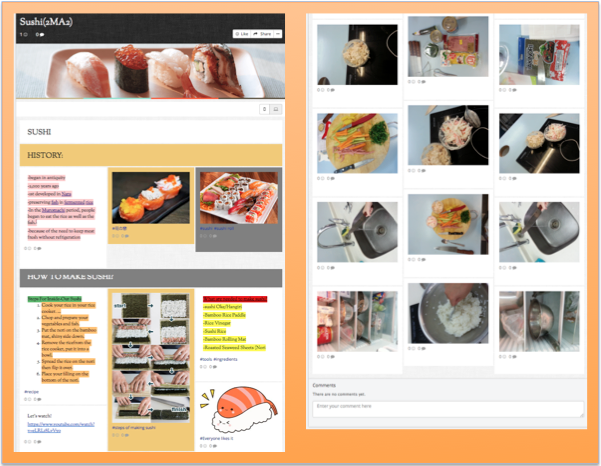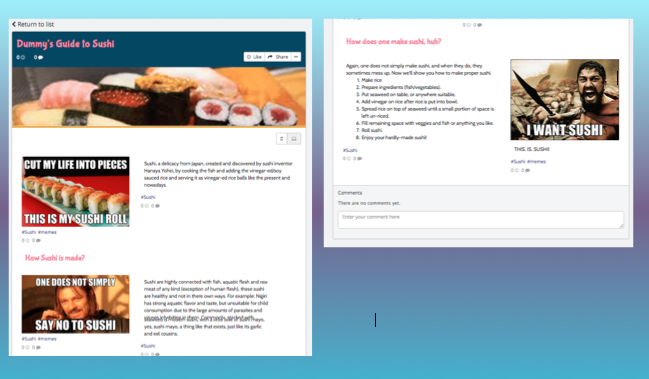There was a time when technology was taught as an isolated subject matter, when word processing, spreadsheets and powerpoint presentations were the scope of the curriculum. It was understood that teaching relevant technology skills was the role of a single subject teacher and took place in the computer lab, but as technology has rapidly interspersed throughout our lives it has become necessary for technology education to be integrated into all subjects. Technology is now a tool to enhance and demonstrate student collaboration, creativity and understanding throughout all discourses and subject matter. The expectation has become that all classroom teachers will authentically and appropriately embed technology into the learning experience. An excellent example of this transition and the positive effect it has had on learning was displayed at Law Ting Pong Secondary School (LTPSS) in Ms Catherine Payne’s Food Science Class.

Students in LTPSS Food Science collaborate to create reflections on their learning using the Teamie Stories feature
Because of the rapid pace of change with technology, teachers’ different comfort levels with tech, teacher turnover, and classroom teachers’ already extensive list of responsibilities, this integration isn’t always seamless. Shared technology tools throughout the curriculum help both students and teachers acclimatise to new technologies and find authentic ways to integrate into day to day teaching and learning. At LTPSS students and teachers use Teamie as a common learning management system and in Ms. Payne’s Food Science class, students heavily leverage the ‘Stories’ feature to collaborate, document and reflect on their experiential learning during a class or unit.
We often think of technology tools as a way to connect students to material at home or outside of the classroom. What was nice to see from Ms. Payne’s students was this in class, online collaboration. Creating these collaborative learning experiences empowers students to work with each other and to assume multiple perspectives, explore alternative solutions, and thoughtfully solve problems. Essentially students in groups make a recipe or prepare a new food and then using the ‘Stories’ feature communicate this experience and learning through the multimedia presentation tool. In this situation there is a nice synergy where a very practical, hands on collaborative learning experience leads and lends to technology integration, as students collaborate on how to best present their learning and experience in the earlier task.

So what was observed as far as the learning environment in our visit to Mrs. Payne’s Food Science Class? We observed a structure which seamlessly connects pedagogy, technology, collaboration and multiple forms of communication, it promoted social learning and led to maximum engagement. A meld of very hands on real world experiential learning complemented with technology integration to showcase said learning, and all with a strong element of collaboration, made for an atmosphere alive with action; teaching, learning, innovating, creating, making, and exploring. The learning environment encouraged both individual and collective voices, and, skillfully utilized emerging technologies, to inspire students to become curators of their digital worlds.

It is a pretty safe bet that these students no matter what their chosen profession will have a technology-infused life and workplace. This requires acquiring the necessary skills for them in a technology-infused learning environment. Technology integration used to be largely focused on teachers using technology tools to present students with material, now we see a necessary shift toward the tools being put in the hands of students and them presenting their learning through them. Teachers then spend less time creating presentations and more time crafting powerful collaborative learning activities, material is covered with more depth, retention is better, and it saves them time and energy in the long run. Moreover, this pedagogy allows students to become explorers and designers, it gives them agency over their environment and validates their voice and abilities as they contribute to a collaborative effort.
In the food sciences class the results were tangible both in that they produced something they could experience and assess in the food that they made and in that they collaboratively created a digital artefact of the experience which they could share. In the traditional educational setting, students composed their work for an audience of one—the teacher. Now, using technological resources to establish authentic audiences for student work, we communicate to students that their work is worth seeing, worth reading, and worth doing. The ‘Stories’ created in Mrs. Pyane’s class can be shared school wide with a ‘Stories Feed’ on Teamie, which creates a library of student learning experiences and reflections, where students can learn from each others experience regardless of subject area or grade level. These ‘Stories’ can even be published and shared with the world. Please press on the links below to view some students of LTPSS communicate their learning in Food Science Stories.
Planning to roll out Learning Technologies to enhance learning pedagogy?
Download this white paper that includes 24 Best Practices for implementing an LMS.



Leave a Reply